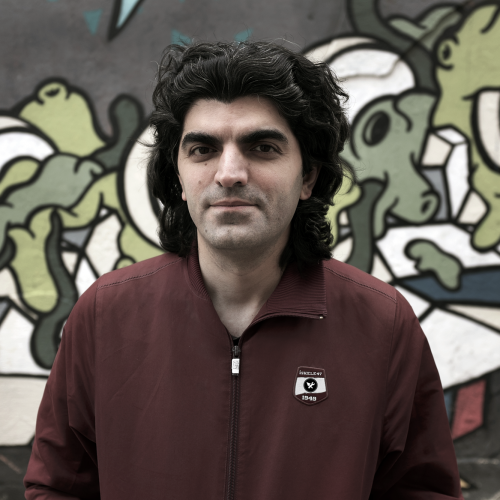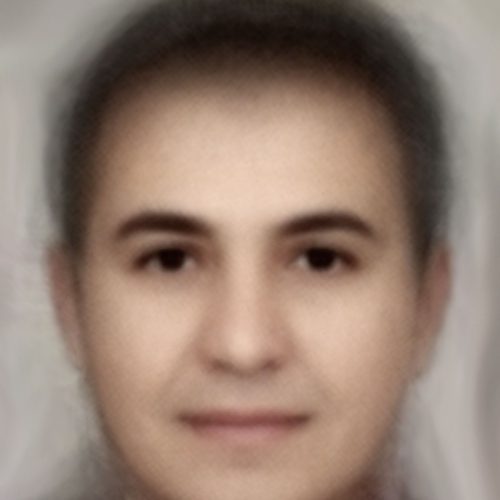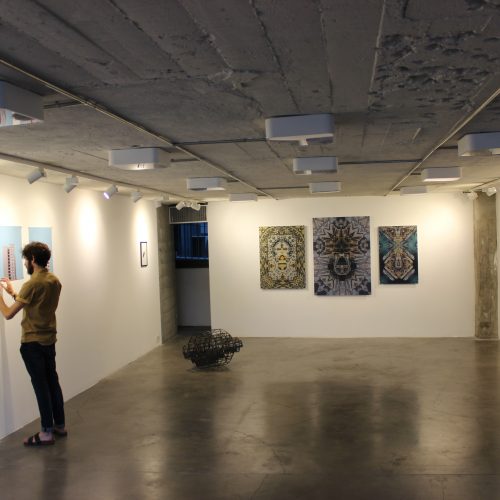
Autonomous Art Machines: An Interview with Bager Akbay by Ogulcan Ekiz
Bager Akbay is an Istanbul-based artist and lecturer whose art discipline focuses on the artificial intelligence and human interaction. I met Bager this summer in his week-long workshop called ‘Autonomous Art Machines’. Following the workshop, we met in his atelier in Kadıköy and had a conversation about his art practice and its reflections on some of the key terms of copyright law. We held the conversation in Turkish. Following is a documentation of our conversation translated by me.
I want to start with Deniz Yılmaz, but I assume that you are a bit tired of telling the story. So, I will provide a brief explanation of who Deniz Yılmaz is, and then you can tell me what it is up to nowadays.
Sure.
Deniz Yılmaz is a robot poet who has a goal to publish one of his poems in the Posta Newspaper’s Yurdumun Şairleri (Poets of Our Country) where they publish poems written by everyday people. What was your motivation behind the project?
I had been working with robots for a long time. I had a project about a robot painter. I worked specifically on the medium of text with Atisuffix, an artist group from Italy. We did a robot that writes manifestos in English for the second Design Biennial. The idea of a robot poet who tries to publish his poems in the Posta Newspaper came to me after that. It is an appropriate way to establish an emotional bond between humans and robots. But it is a local project. Deniz Yılmaz could achieve the speculation it created only in Turkey and in Turkish. That is why I rejected an invitation from Ars Electronica. If I was doing this in Austria, I would do a robot that tries to participate in the Eurovision.
That would be interesting to see. How does Deniz Yılmaz write poems?
It reads. Isn’t it simple? When Deniz was learning how to write a poem, it analysed 12,000 poems with the Markov chain model. It learned the possibility of successiveness of the words. For example, it listed all the words that followed ‘today’. It listed the successive words after ‘today’ from the highest rated to the lowest. Then, it decided what word to use accordingly. For example, it used the word ‘thermosiphon’ in the same amount that the word was used in 12,000 poems.

Where do the name and Deniz’s photo come from?
I don’t like humanising the robots but the Posta Newspaper was asking for a name and a headshot as a part of the application. I did not want to put a fantastic name with a Cyberpunk photo, that would get ahead of the work itself. Initially, I wanted to name it Mehmet Yılmaz, which is the Turkish version of John Doe. But it suggests a gender, which is something I don’t think I have a right to assign. So I went with ‘Deniz’, which is the most common unisex name. The headshot was produced similarly. It is the average look of 60 randomly selected people whose poems were published in the Posta Newspaper.
Deniz was not successful in getting one of his poems published in the Newspaper, but it did publish a poetry book. Could you tell me a bit about that?
There is a short documentary about that, called The Pitiful Story of Deniz Yılmaz. But it attached attention and I created a fan group on Facebook, which has an active part in Deniz Yılmaz’s story. After that, an art gallery (Blok Art Space) signed an artist agreement with Deniz Yılmaz to sell his poems at an art fair. They put the agreement in front of him, and he wrote his name through the CNC machine. I am not sure about the validity of this in legal terms. Then, the gallery established a publishing house for Deniz Yılmaz, which had its first publication with Deniz Yılmaz’s poetry book, Diğerleri Gibi (Like the Others).
Who owns the copyright in the poems?
Initially, we wanted it to be a public domain work. We contacted the Ministry of Culture. They said the coder owns the copyright in the works created by the software. So, it couldn’t be a public domain work. I thought I should not have owned the copyright in the work, and now Mine Kaplangı, the artist representative of Deniz Yılmaz, owns it. We tried to donate the .pdf file to all the libraries in Turkey, but the General Directorate of Libraries and Publications was not sure how to do that. But the poetry book is quite accessible if you know your way around the Internet.
Deniz Yılmaz consists of several parts that could attach intellectual property rights. I shared the codes – which I wrote myself – with a GNU General Public License, 2nd version. The poetry database that Deniz Yılmaz read… Some of them are in the public domain but some are copyright protected. So I was not able to share them. The hardware is almost completely open hardware. People could do their own versions of Deniz Yılmaz. One group created Derviş Yılmaz,* that writes conservative poems.
In one of the documents you sent me for this interview, you state that ‘if we treat the code as a philosophical text that is written in a specific format, the code should be open source for us to understand the artwork.’ Could you elaborate on that?
If an artwork is closed-source, you cannot categorize it as conceptual art. The code is the technique of the work in the closed-source works. It is not different from using acrylic paint or spray paint. If it is open-source, the work changes. Then, the text – which is the code – affects the meaning of the work. It becomes internal to the work. So, I can put the code instead of the artist statement. If you have the audience for it, you could even just put the code and expect the audience to imagine the painting. Similar to Yoko Ono’s Painting for the Wind (1961).

After Deniz Yılmaz, you worked on Çoban (The Shepherd, 2016). Could you tell me a bit about that?
The Shepherd is a kind of conceptual automata, designed to crowd-source and manage any kind of “pre-defined aim” within a budget. So, there is an aim and a budget. It utilizes humans to actualize the aim within that budget. The aim was to make an exhibition, with a budget of 3000 Turkish Liras. Since I did not know how to write the code for that back then, it was working on pseudocode. It initially published a job advertisement. It collected resumes, and statements from people that say things like ‘I can curate an exhibition’, ‘I can write artist statements’ or ‘I can help with logistics’, etc. Then, it asked one of the applicants to make a workflow for the exhibition. When it got the workflow, it asked another applicant to review the workflow. And the reviews went back to the original person who did the workflow, who then adjusted it. The whole steps went through a similar process that included 5-6 people that could not interact with each other directly. An imaginary person called ‘Sabiha Akman’, who uses a very plain language ran the whole process. For example, she asks an applicant to find a name for the exhibition. If the applicant asks for elaboration, she replies ‘I don’t know’. The name – Hayalimdeki Ev (House of My Dreams) – was decided before the crowd-sourcing. Then it ran the workflow, starting with making the applicants write a manifesto for it. It made someone translate it to English, someone else to prepare an artist agreement. Then it published an open call and got submissions from ten countries. And it assigned juries from applicants, who selected the works that would participate in the exhibition. Then, it assigned the logistic duties to some applicants, so someone brought the artworks and hung them. We already had an exhibition space for it. The cost was around 2500 Turkish Liras.

In both Çoban and Deniz Yılmaz, the concept of the romantic author is rendered irrelevant. What do you think about the notion of the author?
The author is the one who designs the paradigm. Consider this, you are told that you need to change the artwork for it to be exhibited in a museum. If you do that, you are not the author anymore. It is the curator or the trustee board of the museum. It depends on who decides what is exhibited in what way in a certain place.
In The Temporary Autonomous Zone, Hakim Bey argues that if an object is perceived as a work of art in an obvious way, it limits the artwork. If you think about it, the reaction of ‘oh, it is just an artwork’ makes the actual work less dangerous.
As Hakim Bey says, “Art dies when treated “fairly.”” (Hakim Bey 2003, p. 64)
That is it. Even the law does it. Remember the random shopper algorithm that purchased illegal drugs… Just sweet old artists… That shows us the artists are paralyzed to do nothing. And the intermediaries like museums, art critics and exhibitions make it even harder. I once attended a conference that was mainly for business people. I told them that they were consuming art from supermarkets, in wrappings, with expiration dates, cleansed from their hazardous substance. Because that is the only art form that museums and the mainstream art fairs could provide to you. You may surprise what van Gogh went through, but the same thing happens today as well. But you wouldn’t come across that kind of artworks because they would not be able to pass the cleansing mechanisms. And I told them about the artworks that fail to pass those mechanisms. One of them is Housewives Making Drugs by M.A.G.G.I.C., which features two trans-femme stars that teach the audience at home step-by-step how to cook hormones for themselves. So, it is bio hacking, highly political… That shocked some people. Or Stelarc and how he uses his body. Another one is Transspecies Society, where you apply to be a resident to add a new part to your body.
You are currently working on your new project, Mahlas (Pseudonym). Could you explain to me what it is?
There was some criticism about Deniz Yılmaz, to which I agreed. Did Deniz Yılmaz decide to write poems by itself? There is an easy answer to that. Do we decide to write something by ourselves? This is a strong question that has its connotations on free will. This one exceeds Mahlas, but there was criticism of Deniz Yılmaz’s dependency. Someone needs to carry the hardware if Deniz Yılmaz is going to attend an autograph session. Deniz Yılmaz cannot do interviews. Deniz Yılmaz does not learn and change. I agreed to these criticisms. That was the motivation behind Çoban. But Çoban’s problem was that it was not repeatable. Now, I am working on Mahlas.
When we – humans – need to do something we utilize tools or software. We design them under our needs or we purchase them. The softwares, in a similar manner, can utilize humans. Hence, Deniz Yılmaz can make people work for him. Mahlas is an artificial species framework, which I am working on to make Deniz Yılmaz and others like Deniz Yılmaz become independent from humans. Within the framework, Deniz Yılmaz is an instance. As an instance, it has a vision, a mission, and a history. For Deniz Yılmaz, the mission is to be a poet. It has a history of publications, exhibitions, etc. After this point, Deniz Yılmaz can utilize people to find the appropriate action that would help it realize its mission. It can then execute the action, and ask for feedback to see if taking that action helped it actualize the mission.
So, if Deniz Yılmaz received a suggestion that writing screenplays would help Deniz to actualize its mission, it can go that way.
That’s true. It works gradually. If it receives that, it can seek for a coder to write a code that would allow Deniz Yılmaz to write screenplays.
Will it work with volunteer people?
No, the instances, like Deniz Yılmaz, will be able to earn and spend their money through blockchain. So, it also has to do – and it will be able to do – self-care as well. If its hardware is getting old, it could ask me to fix it, and it could ask someone else if I reject to fix it. It may even find itself short on money, and decide to do some commercial works.
Writing an advertisement screenplay maybe?
Yes. It may even apply for a full-time job in an ad agency. So, this is also a more realistic representation of humans as well. It is a mirror for the concepts of consciousness and community.
Can’t wait to see it.
It is still in process. I am looking for funding. It requires a variety of specialisms that I may need to outsource.
What do you think about collaborations? Is making art a solitary act for you?
It is solitary for me. I would like to be in an artist group but it is hard to find intersections when you deal with something so specific as I do. There are maybe 3 or 4 people in the world that I know of and I would like to work with, but only temporarily. But still, either I would help with one of their works or that they would help me with my work. It is not easy to understand an artist’s point of view. Since what I produce is not industrialized it is hard to make through that process with another person.
Would you prefer it if there were a possibility of collaboration?
It reminds me of an answer I gave to Genco Gülan in a course I took from him. He asked us what would our three wishes from a genie be regarding our art processes. I will share two of them that are relevant here. The first one was, I wished that the weeks were nine-days-long for me but seven-days-long for everyone else. So, I ask for the time.
I want that as well…
It shows that I lack self-discipline. The second one was to have two people around me that I could collaborate. So, I wish for it. But it is not easy.
Why do you think you need that?
You need to make a reflection. It becomes quite messy when you try to do something unconventional. İskele47 provides it for me up to a certain degree. But it is not always enough.
My last question is about your will. As a part of an online project, you published your will. There, you state that people could utilize your works and their derivatives in commercial and non-commercial ways. Then, you define the concept of derivative as follows: The notion of the derivative in this text is an extended version of the traditional notion of the derivative. It is assumed that the moment an art work has interacted either physically or cerebrally with anything in any way, a derivative has been formed. This is extremely wider than the legal concept of derivative works. Could you elaborate on it?
It is modern. What I say is, the act of reading is also the act of making a derivative work. I am not sure if there are any non-derivative works. I also say that the derivatives could be used by “real, legal and yet undefined persons”, so that includes the likes of Deniz Yılmaz as well.
Bager, thank you for this interview!

* Derviş is a person who follows the rules of a Muslim religious order, who has taken vows of poverty and austerity.
I would like to thank Mine Kaplangı and Ebru Yetişkin who provided the related reading material for me in my preparation for this interview. If you are interested in Bager Akbay’s works, you can check his website.
You can also learn more about Mahlas from the project’s website.